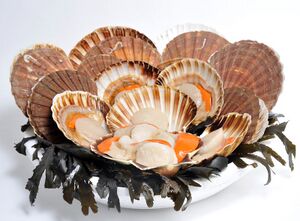Coquille Saint-Jacques des Côtes d'Armor (Côtes d'Armor scallops)

IGP Coquille Saint-Jacques des Côtes d'Armor is a natural fish product of the species pecten maximus (common scallop). The certified IGP Coquille Saint-Jacques des Côtes d'Armor is marketed without additives or colourants in three forms: whole and either fresh or frozen shelled.
Geographical area
Recognized natural bed in the Côtes-d'Armor (French department). Fishing zone with strictly regulated access, clearly identified and delimited.
Proof of origin
Very productive, famous bed which has been farmed regularly since the beginning of the 1960s. Alone it provides 90 % of Brittany's production and almost 50 % of national supplies. Licensed fishermen who are authorized to fish the recognized natural bed, identify the bags of landed coquilles Sant-Jacques with a label. This identification is then maintained throughout processing.
Method of production
Shellfish are fished during the winter period using a small, local fleet. Management of this stock is subject to very strict regulations which serve as a reference for the exploitation of other resources along the French coasts. The whole, live coquille Sant-Jacques is conditioned in wooden baskets. The coquille Sant-Jacques meat is taken from a live coquille Sant-Jacques. The maximum time allowed between fishing and shelling is two days. It is a short, rapid process.
Link
The IGP Coquille Saint-Jacques des Côtes d'Armor reproduction cycle is atypical. This well-know bed has several special features (geographical, hydrological, biological). This is a well-recognized local product which provides more than 40 % of annual output of seafood products in the Cotes-d'Armor.
Gastronomy
IGP Coquille Saint-Jacques des Côtes d'Armor is stored in a cool and well ventilated place. They can also be stored in the least cold compartment of the refrigerator in a clean cloth, where they will keep for up to three days. From a gastronomic point of view, the exquisiteness of its meat makes it a simple and sophisticated dish that has always seduced the greatest of chefs, as it is ideal for a great many dishes and satisfies the most delicate of palates. It is accompanied well with butter, cream, cider and apples and goes well with winter vegetables, such as endives. The shells are usually accompanied with salad, cooked on skewers with fruit, or au gratin with breadcrumbs and béchamel sauce. It is advisable not to overcook and to cook them just before serving.
Reference: The European Commission
#frozen #fish #fruit #butter #fishandseafood #vegetables #shellfish #apples #refrigerator #endives #cream